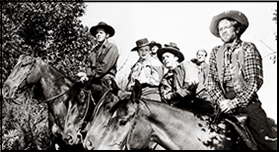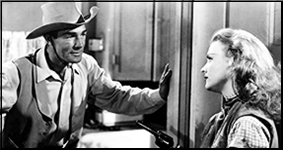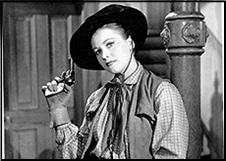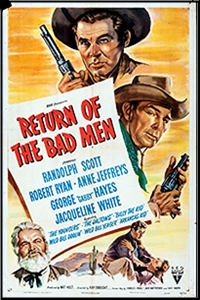Mon 6 Jul 2020
A Western Movie Review: RETURN OF THE BAD MEN (1948).
Posted by Steve under Reviews , Western movies[6] Comments

RETURN OF THE BAD MEN. RKO Radio Pictures, 1948. Randolph Scott, Robert Ryan, Anne Jeffreys, George ‘Gabby’ Hayes, Jacqueline White, Robert Armstrong. Director: Ray Enright.
It must have seemed like a good idea at the time. Bring together all of the famous bad men of the west, or a good passel of them, whether or not they ever met each other in real life, or were active at the same time, and create a gang of outlaws even a figure as solid and stalwart as Randolph Scott could handle them. Audiences would simply flock in, or I’m sure that’s what was the expectation was.
I haven’t researched the historical facts well enough to tell you whether anything in this movie is true, but I doubt it. In any case, the result is surprisingly sub-par. Not even the evil presence of Robert Ryan as the Sundance Kid, nor the alluring beauty of Anne Jeffreys as Cheyenne, the niece of Wild Bill Doolin, help a lot to make Return of the Bad Men more than a barely passable way to spend 90 minutes f your time.

For the record, here’s a list of the outlaws that gangleader Bill Doolin (Robert Armstrong) puts together: The Youngers (Cole, Jim and John), the Daltons (Emmett, Bob and Grat), Billy the Kid, Wild Bill Yeager, and the Arkansas Kid. I hope I didn’t leave anyone out. I didn’t list any of their names as part of the cast because other than Robert Ryan, who’s as mean as they come, all of them are very minor roles.
It turns out that Randolph Scott has a sweetheart that he plans to marry, but what Anne Jeffreys’ character, once reformed (or is she), thinks about that is that she will have something to say about it. Scott is quite oblivious. Unfortunately, the writers not knowing how to write themselves out of this romantic triangle they’ve written themselves into, take the weakest, lamest way out.

George ‘Gabby’ Hayes, as a bank president, no less, adds comedy relief, but the story is overwhelmed by characters who are simply not very interesting. Not even the sight of the masses of men on horseback and in flimsy wagons at the beginning of the Oklahoma Land Rush adds any excitement to the proceedings.
Passable entertainment, but barely. Only the sharp, clear black and white photography is worth a mention (J. Roy Hunt , cinematographer). Credit where credit is due.

July 6th, 2020 at 12:33 am
For Dan Stumpf’s review of this same film, go here:
https://mysteryfile.com/blog/?p=55813
July 6th, 2020 at 11:28 am
There was an episode of MAVERICK with a similar plot which had Bret counting up the reward money,
I remember Joel Grey playing Billy the Kid.
July 6th, 2020 at 1:24 pm
Right you are, Ray:
https://www.imdb.com/title/tt0644449/reference
“Full House” Season 3 Episode 7
IMDb: “Bret, fearless mastermind of super-villain gang Billy the Kid, Belle Starr, Cole Younger etc. ? Mistaken for the mysterious dandy, Foxy the Brain, Bret must whip out a fool-proof heist blueprint for this Axis of Evil summit of the West. Luckily, the real Foxy’s in jail after a poker dispute with Bret, but what jail can hold the slippery Foxy ? At least the amorous Belle Starr’s floored by Bret’s charm, but the other legendary outlaws put Bret to the test.”
July 6th, 2020 at 1:00 pm
An interesting review that I do not agree with at all, but the most fascinating, for me, is how fashionable Robert Ryan has become, somewhat though not totally warranted. There was not a day in his career, no matter the reviews that he could dominate any top star. In this way, he reminds me of Robert Preston, recently seen in Whispering Smith. Clearly an entertaining and terrific performer, but could not come close to taking the film from Alan Ladd.
July 6th, 2020 at 1:30 pm
I wrote this review maybe six or seven years ago, stuck it in a file to be posted, then forgot about it until last night. Maybe it should have stayed there, but I think I just couldn’t get over the historic silliness of the whole affair. Dan Stumpf seems to have gotten over that hurdle in his review a lot better than I managed to.
July 7th, 2020 at 9:00 pm
I doubt the Sundance Kid ever met Bill Doolin, known as the “good outlaw,”but the shootout at the outlaws hideout is based on history, and happened here in Oklahoma involving Heck Thomas (who killed Doolin). Scott’s character seems to be a cross between Thomas and Bill Tilighman (who had captured the then escaped Doolin).
This is pretty much B movie fantasy, but various incidents in it were written by someone who at least knew some outlaw history, and mixed it all up in a loose B stew.
Of course in real history the James Brothers rode with the Youngers so such outlaw gangs weren’t unknown.